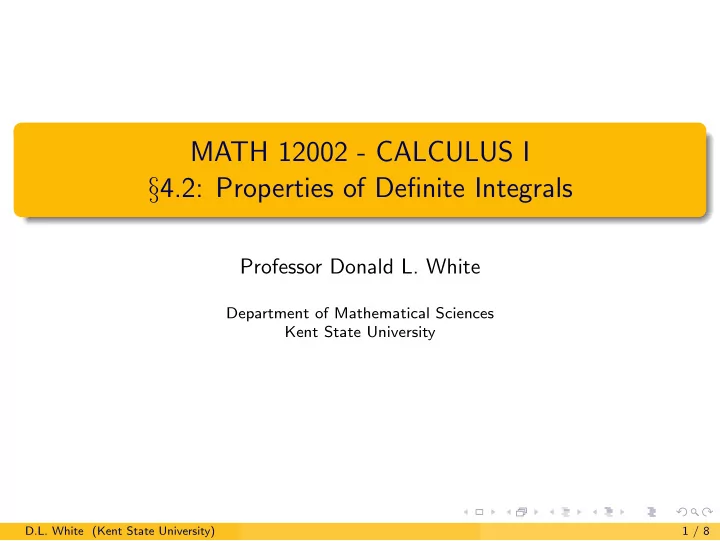

MATH 12002 - CALCULUS I § 4.2: Properties of Definite Integrals Professor Donald L. White Department of Mathematical Sciences Kent State University D.L. White (Kent State University) 1 / 8
Algebraic Properties The first property of definite integrals is really more of a convention. (It will be compatible with the Fundamental Theorem of Calculus.) � a � b f ( x ) dx = − f ( x ) dx ; 1 b a that is, interchanging the limits of integration negates the integral. The next two properties follow either from the definition of the integral or from the area interpretation of the integral. � a f ( x ) dx = 0. 2 a � b c dx = c ( b − a ) for any constant c . 3 a D.L. White (Kent State University) 2 / 8
Algebraic Properties Since the definite integral is a limit of sums, it seems reasonable that it should “respect” sums and constant multiples as limits do. � b � b � b [ f ( x ) + g ( x )] dx = f ( x ) dx + g ( x ) dx . 4 a a a � b � b cf ( x ) dx = c f ( x ) dx for any constant c . 5 a a � 12 � 12 6 x 2 dx = 504 and EXAMPLE: If we know that 6 x dx = 54, then � 12 � 12 � 12 � 12 (3 x 2 + 2 x + 5) dx 3 x 2 dx + = 2 x dx + 5 dx 6 6 6 6 � 12 � 12 � 12 x 2 dx + 2 = 3 x dx + 5 dx 6 6 6 = 3(504) + 2(54) + 5(12 − 6) = 1650 . D.L. White (Kent State University) 3 / 8
Algebraic Properties Both properties (4) and (5) follow from the definition of the integral. For property (4), we have � b n � [ f ( x ) + g ( x )] dx = lim [ f ( x ∗ i ) + g ( x ∗ i )]∆ x n →∞ a i =1 � n n � � � = lim f ( x ∗ i )∆ x + g ( x ∗ i )∆ x n →∞ i =1 i =1 n n � � = lim f ( x ∗ i )∆ x + lim g ( x ∗ i )∆ x n →∞ n →∞ i =1 i =1 � b � b = f ( x ) dx + g ( x ) dx . a a The verification of property (5) is similar. D.L. White (Kent State University) 4 / 8
Algebraic Properties BE CAREFUL! This does not work for products: � b �� b �� b � � [ f ( x ) g ( x )] dx IS NOT EQUAL TO f ( x ) dx · g ( x ) dx . a a a Although it is true that the limit of a product is the product of the limits, the manipulations we did for the integral of a sum do not work, because n n n � � � [ f ( x ∗ i ) · g ( x ∗ i )]∆ x � = f ( x ∗ i )∆ x · g ( x ∗ i )∆ x . i =1 i =1 i =1 D.L. White (Kent State University) 5 / 8
Algebraic Properties We can integrate over one piece of the interval at a time and then add the results to compute the integral over the whole interval. � b � c � b f ( x ) dx = f ( x ) dx + f ( x ) dx . 6 a a c Although this is normally used in the case where a < c < b , it is valid as long as all three integrals exist. If c is not between a and b , it follows using the property that � a � b f ( x ) dx = − f ( x ) dx . b a D.L. White (Kent State University) 6 / 8
Comparison Properties The rest of the properties are used to compare and approximate integrals. They are less useful for direct calculations of integrals. � b 7 If f ( x ) � 0 for a � x � b , then f ( x ) dx � 0. a � b If f ( x ) � 0 for a � x � b , then f ( x ) dx � 0. a These are useful as a rough check of calculations. Applying property (7) and the sum property to f ( x ) − g ( x ), we obtain � b � b 8 If f ( x ) � g ( x ) for a � x � b , then f ( x ) dx � g ( x ) dx . a a This can be used to obtain a rough estimate for an integral if we know the integral of a larger or smaller function. D.L. White (Kent State University) 7 / 8
Comparison Properties We can estimate an integral if we know constant bounds on the function. Applying property (8) and the integral of a constant, we obtain 9 If m and M are numbers such that m � f ( x ) � M for a � x � b , then � b m ( b − a ) � f ( x ) dx � M ( b − a ). a D.L. White (Kent State University) 8 / 8
Recommend
More recommend